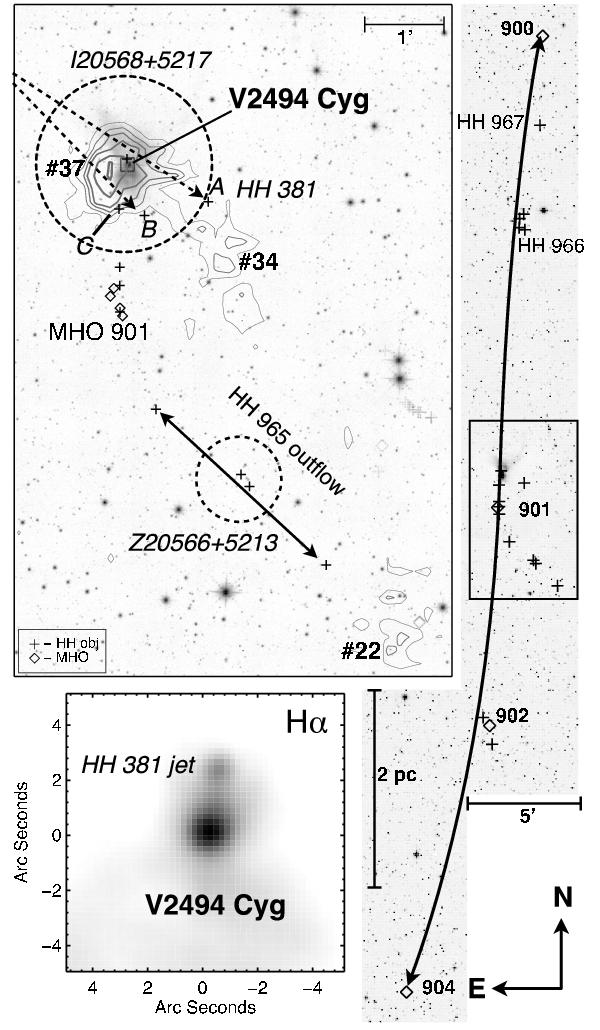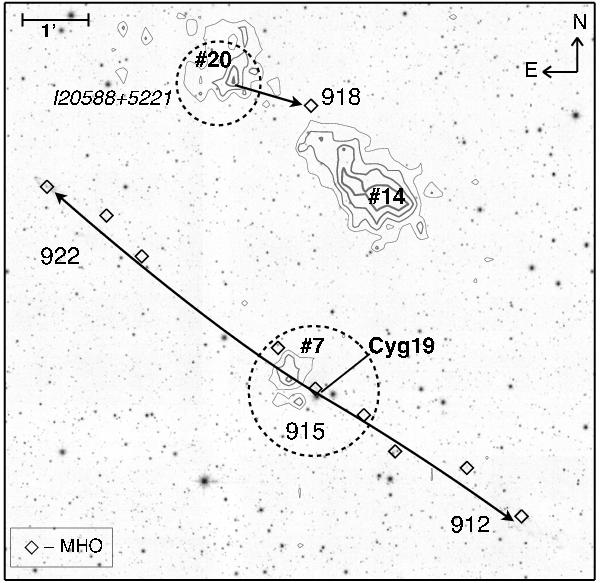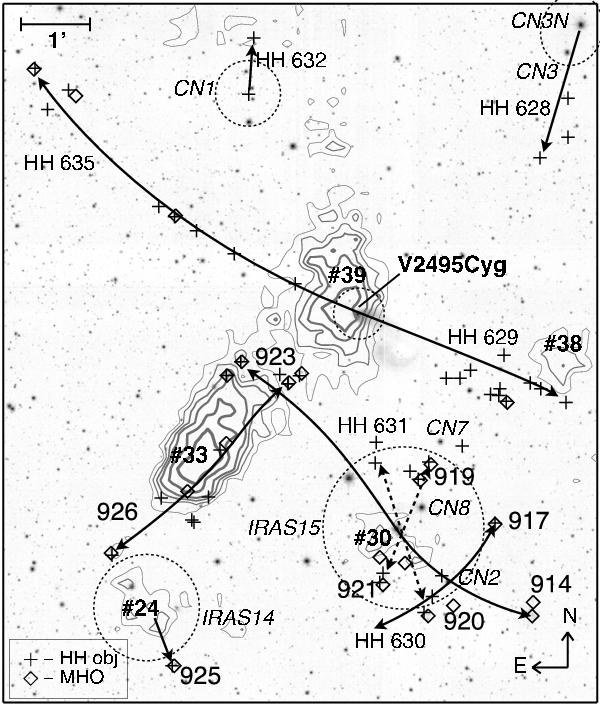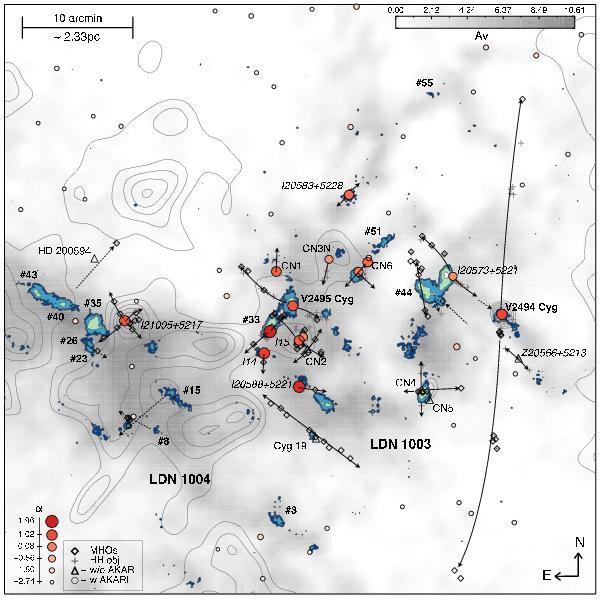Free Access
Table D.1
Detailed descriptions of the sub-regions where MHOs (see Table A.1) were identified.
| Images | Description |
|
|
|
 Download original image  Download original image  Download original image |
Area including MHO 900. Despite the overall resemblance to an edge-on disk system with a bipolar outflow cavity we were unable to identify any IRAS or AKARI sources here. The system is most likely a broken bow-shock driven from V2494 Cyg. |
|
|
|
 Download original image  Download original image  Download original image |
Area including the MHO 901 complex coinciding with the optical HH 382G, F and E knots. |
|
|
|
 Download original image  Download original image  Download original image |
Area including the MHO 902 knots which coincide with the optical HH 382A, B and C knots. |
|
|
|
 Download original image  Download original image  Download original image |
This sub field includes MHO 903 which is rather diffuse in structure. |
|
|
|
 Download original image  Download original image  Download original image |
The area shows the MHO 904 knots which belong to the outflow emanated from V2494 Cyg. These are the most southern knots discovered in our survey. |
|
|
|
 Download original image  Download original image  Download original image |
MHO 905 is a small bow-shock, the origin of which is still unknown. |
|
|
|
 Download original image  Download original image  Download original image |
This is one of the knots in the MHO 906 outflow. This feature is associated with HH 380F. |
|
|
|
 Download original image  Download original image  Download original image |
Part of the MHO 906 outflow coinciding with HH 380B. |
|
|
|
 Download original image  Download original image  Download original image |
Last part of the MHO 906 outflow coinciding with the optical feature HH 380C. Morphologically it resembles a bow-shock driven from the southeast. In this current work we assume an outflow direction to the southwest. |
|
|
|
 Download original image  Download original image  Download original image |
Area includes the MHO 907 complex bow shock which coincides with the faint object HH 970. IRAS 20575+5218 is unrelated to this flow. |
|
|
|
 Download original image  Download original image  Download original image |
Region including the MHO 908 chain of knots A to D, where knot D might be related to HH 974B. The IRAS 20575+5210 error ellipse and CN4 are marked for reference. |
|
|
|
 Download original image  Download original image  Download original image |
Area shows a chain of relatively faint knots comprising MHO 909. |
|
|
|
 Download original image  Download original image  Download original image |
Area shows the details of MHO 910, which is associated with the prominent optical bow-shock HH 380(A). There is a faint extension to the east-northeast (MHO 910B) which could be unrelated to this flow. MHO 910C also coincides with HH 380E. |
|
|
|
 Download original image  Download original image  Download original image |
Region where the MHO 911 bow-shock can be seen. This quite prominent and compact bow also coincides with HH 627A. |
|
|
|
 Download original image  Download original image  Download original image |
Figure shows the complex bow-shock structure MHO 912, which is part of a prominent bipolar outflow that is only detected in the near-infrared. |
|
|
|
 Download original image  Download original image  Download original image |
Area including the compact bipolar outflow MHO 913, emanating from IRAS 20583+5228. Knots A and B correspond to HH 975A and B. |
|
|
|
 Download original image  Download original image  Download original image |
Figure shows the complex bow-shock structure of MHO 914. |
|
|
|
 Download original image  Download original image  Download original image |
Area including the MHO 915 chain of knots emanating from Cyg 19. These are part of a prominent near-infrared bipolar outflow. |
|
|
|
 Download original image  Download original image  Download original image |
Region including the faint knot MHO 916 which coincides with HH 629 and emanates from V2495 Cyg. |
|
|
|
 Download original image  Download original image  Download original image |
The compact knot MHO 917 coinciding with HH 670. |
|
|
|
 Download original image  Download original image  Download original image |
The faint diffuse bow-shock MHO 918. |
|
|
|
 Download original image  Download original image  Download original image |
MHO 919 knots also coinciding with the HH 631 knots D and E. |
|
|
|
 Download original image  Download original image  Download original image |
Area including MHO 920 and 921 which is also full of HH objects, some coinciding with the near-infrared features. The IRAS 20588+5215 (IRAS 15) error ellipse is shown, as is the position of CN2. |
|
|
|
 Download original image  Download original image  Download original image |
Area including the extensive and rather complex chain of bow-shocks MHO 922, which is part of a near-infrared bipolar outflow. |
|
|
|
 Download original image  Download original image  Download original image |
Region showing the complex object MHO 923, which coincides with HH 448 and is also known as RNO 127. MHO 926A, which coincides with HH 634A, can also be seen in this image. |
|
|
|
 Download original image  Download original image  Download original image |
Area shows the MHO 924 bright knot which coincides with HH 635A. |
|
|
|
 Download original image  Download original image  Download original image |
Area shows MHO 925 which coincides with HH 633. |
|
|
|
 Download original image  Download original image  Download original image |
Area shows the MHO 926 outflow, which also coincides with the optical HH 634 outflow. |
|
|
|
 Download original image  Download original image  Download original image |
Region shows the MHO 927 group of knots and bow-shocks which coincide with HH 635B and C. This is part of the flow driven by V2495 Cyg. |
|
|
|
 Download original image  Download original image  Download original image |
Group of bows and knots emanating from IRAS 21005+5217. MHO 928 and 929 are thought to be the part of a west-to-east or east-to-south bipolar flow. MHO 930 is part of a bipolar outflow extending in a SW-NE direction. |
|
|
|
 Download original image  Download original image  Download original image |
Area including MHO 932 and 931. These two objects are thought to belong to different flows. |
|
|
|
 Download original image  Download original image  Download original image |
Region shows the MHO 933 knots which are thought to be driven by IRAS 21005+5217. MHO 933 belongs to the same bipolar outflow as MHO 928 and 929. |
|
|
|
 Download original image  Download original image  Download original image |
The area shows the MHO 934 chain of bow-shocks which are thought to be driven by a source somewhere in the SE. |
|
|
|
 Download original image  Download original image  Download original image |
Region shows MHO 935 which is driven by IRAS 21005+5217. MHO 935 belongs to the same bipolar outflow as MHO 930. |
|
|
|
 Download original image  Download original image  Download original image |
Area shows MHO 936 which has quite a complex structure. It is thought to be driven by a source somewhere in the northeast. |
In each case images are presented in H2 1−0 S(1) line emission before (left) and after (right) continuum subtraction. The positions of known Herbig-Haro (HH) objects, cometary nebulae (CN) and IRAS sources are indicated.
Current usage metrics show cumulative count of Article Views (full-text article views including HTML views, PDF and ePub downloads, according to the available data) and Abstracts Views on Vision4Press platform.
Data correspond to usage on the plateform after 2015. The current usage metrics is available 48-96 hours after online publication and is updated daily on week days.
Initial download of the metrics may take a while.


